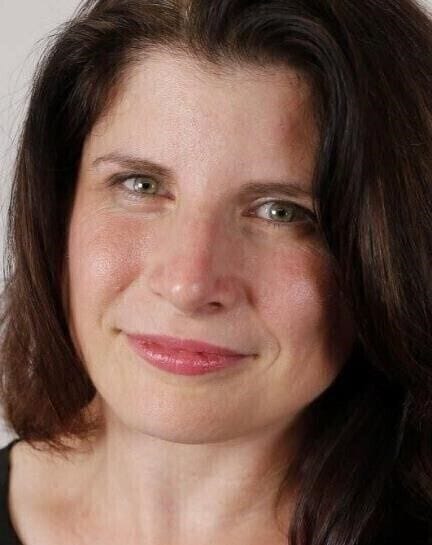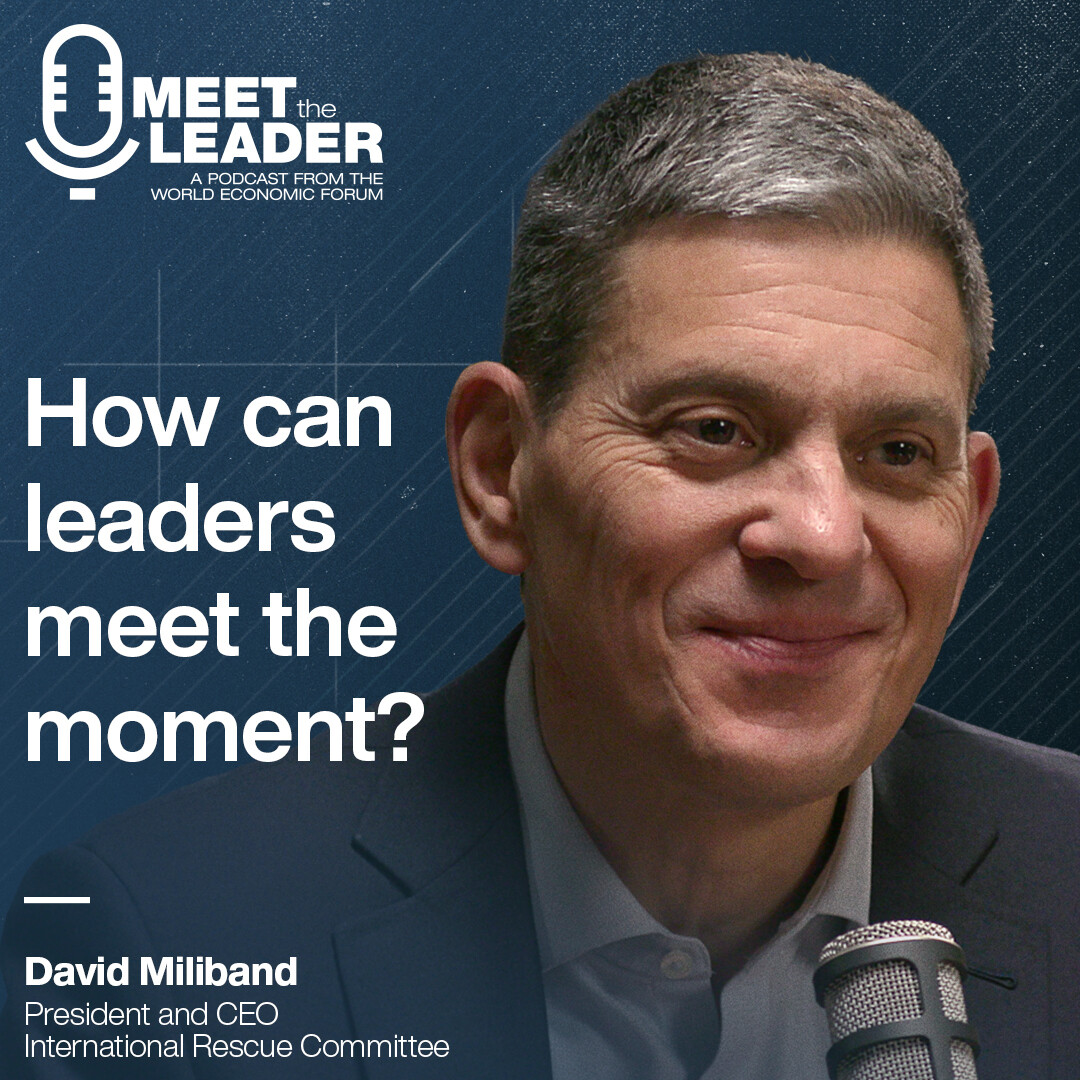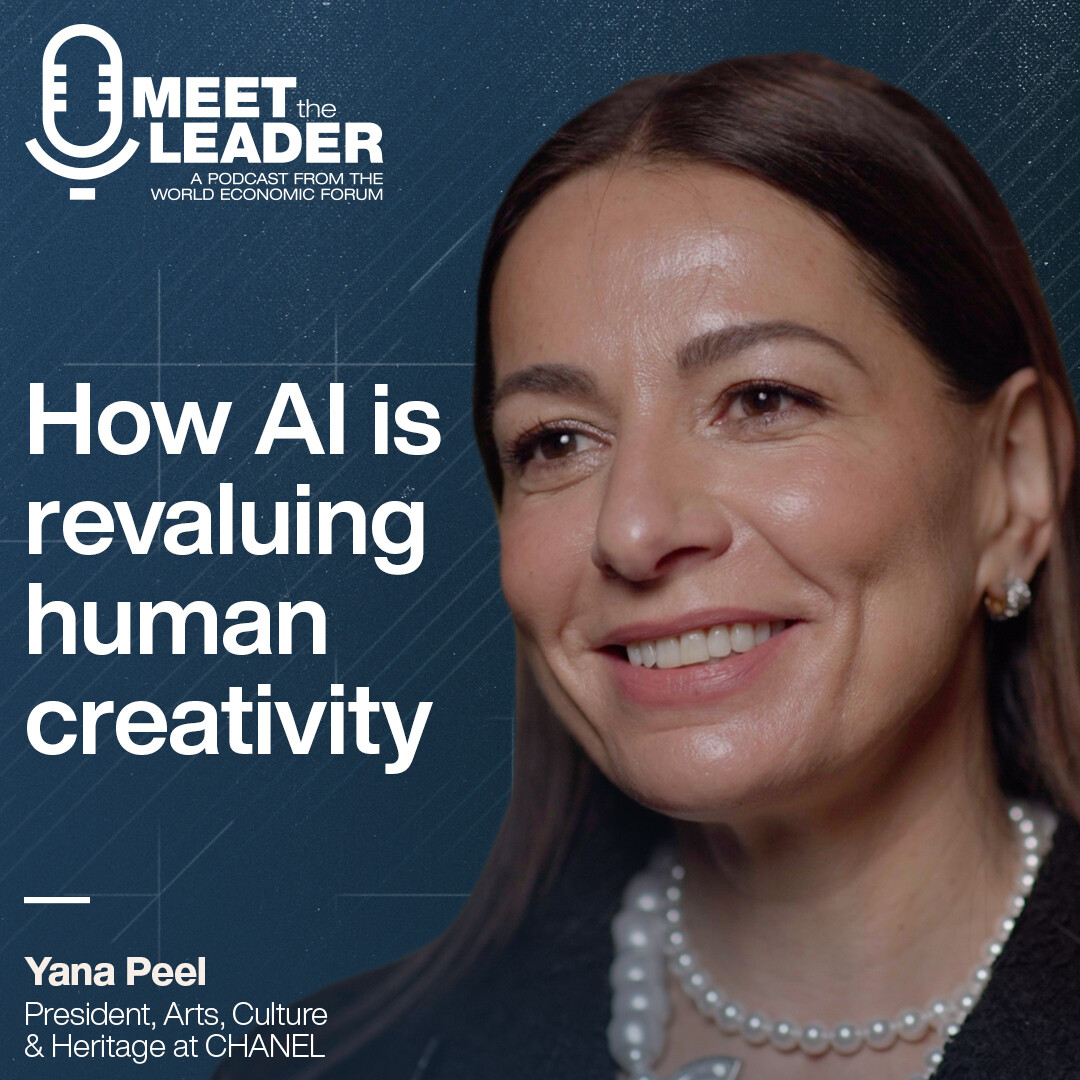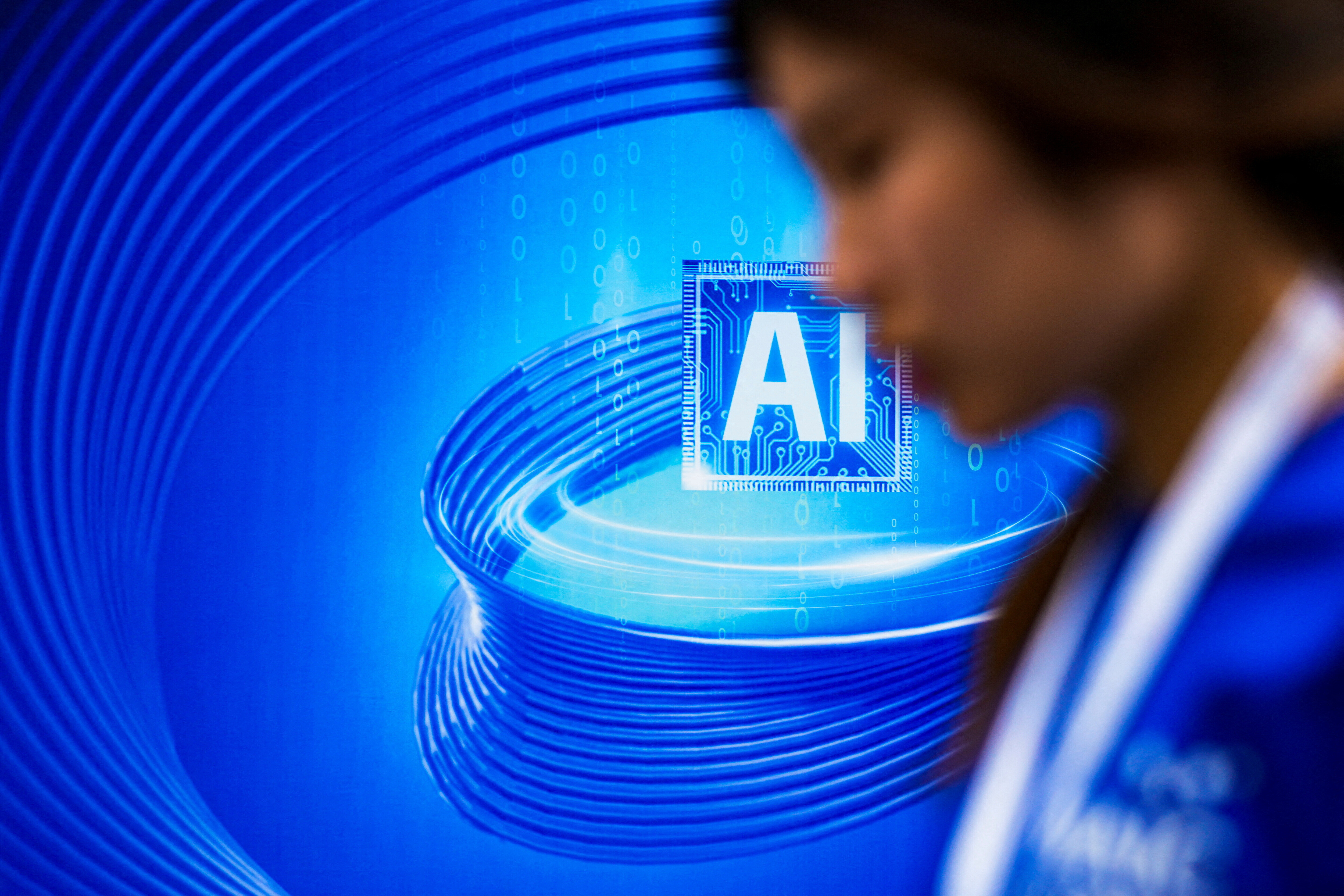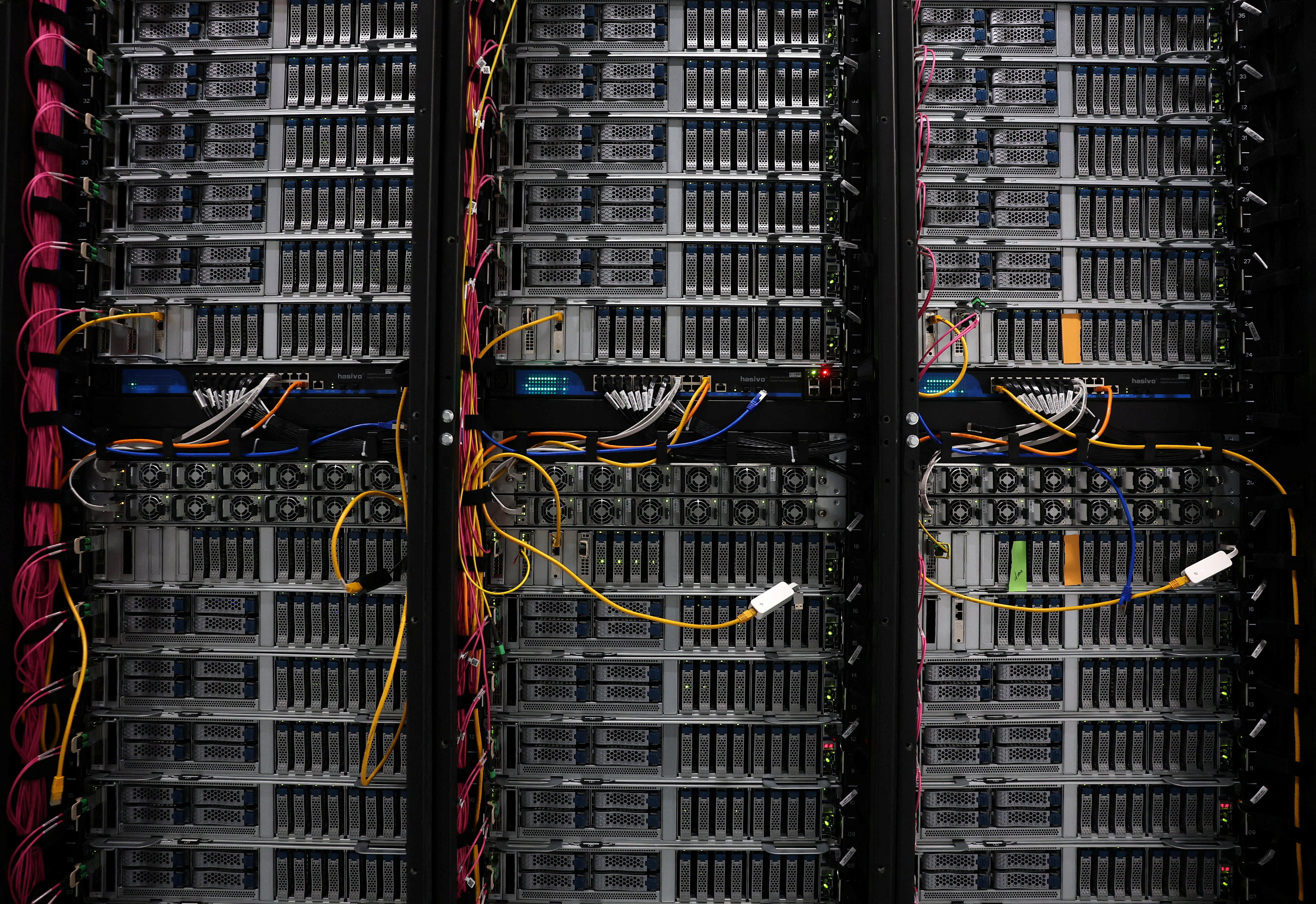Meet the startup building the first commercial space station
Transcripción del podcast
Linda Lacina, Meet The Leader Welcome to Meet the Leader, the podcast where top leaders share how they're tackling the world's toughest challenges. Today's episode, We talked to Tejpaul Bhatia the chief revenue officer at Axiom Space, all about building the first ever commercial space station and what's needed to truly work and live one day in space.
Subscribe to Meet the Leader on Apple, Spotify and wherever you get your favorite podcasts. And don't forget to rate and review us. I'm Linda Lacina. From the World Economic Forum. And this is Meet the Leader.
Tejpaul Bhatia, Axiom Space We have learned as a species how to survive in space, and it's time to learn how to live in space.
Linda Lacina, Meet The Leader The International Space Station is a marvel of modern engineering and cooperation. It was assembled in orbit over a span of ten years, all thanks to the collaboration of five space agencies representing 15 countries.
All good things come to an end and the station -- some sections designed in the 1980s -- will need to be decommissioned by 2031.
New changes to come will reflect the ways that we are using space now to support everything from science to the space economy, something that our research says could grow into a $1.8 trillion sector by 2035.
Axiom Space runs end-to-end missions to the International Space Station, and it won the commission to build its successor: the first ever commercial space station. I had the chance to talk to its chief revenue officer, Paul Basha, this spring in San Francisco. He talked to me about the research missions the company operates there helping it better understand what we'll need to work and one day live in space. He also shared how those learnings, decades of space exploration experience, will find their ways into the design of the new Axiom Station.
And while it employs its share of astronauts and rocket scientists, this unique company also designs spacesuits like the one for the upcoming Artemis Moon mission set for 2026. This means it also counts sewers costumers from places like Cirque du Soleil on its team who understand performance fabrics and who have the skill sets to hand sew parts of uniforms that can't be tackle with machines. He'll share how this diverse group works together and how learning how to tap such a range of skill sets is a window into both what's ahead for the future and building the space economy. He'll talk all about this, but first, he'll get us started with more on Axiom Space.
Tejpaul Bhatia, Axiom Space Axiom Space is developing a successor to the International Space Station. So the core of our business is Axiom Station, where our first modules will start docking onto the International Space Station late 2026. And our job right now is to finish our station before the end of life of the International Space Station.
In addition to developing Axiom Station, we have two other business units. One is our spacesuits business. So when our engineers and our astronauts and our customers use Axiom Station and do extravehicular activity as they'll be in Axiom suits. But the bigger news is we're also developing a lunar suit for the Artemis mission. So the next human who steps on the moon will be wearing an Axiom suit.
And we also have our missions business.So prior to Axiom segment, the first module that attaches on to recess, we have what we call precursor missions. These are crewed missions to the International Space Station, where we take other nations to be part of that experience. We've done three missions to date over the last three years, taking eight nations up to the ISS. And our next mission, where we will take another three customers and nations up as we build to our station.
Linda Lacina, Meet The Leader I want to start with the International Space Station being decommissioned. Tell us why. Why do we need to rebuild this and start new?
Tejpaul Bhatia, Axiom Space So the International Space Station is an incredible feat in engineering, collaboration, diplomacy.15 different countries across five agencies the US, Canada, Japan, Europe and Russia came together to build this habitat and lab that's orbiting the Earth. And we as a species have had people living off planet that entire time.
Now, while it is a habitat and feels like a building, it's more like a piece of equipment and it has a certain lifespan and we're approaching that life span very quickly and it needs to be decommissioned and replaced. Otherwise the cost of maintaining it will be very high. And the decision made was that commercial companies will take over this part of space exploration. And this is why the strategy was created. This is why Axiom exists. Axiom 1, what's called a port contract that gives our company the exclusive right to develop off of the International Space Station.
Linda Lacina, Meet The Leader This new commercial space station, how will it be different? Right. We've got an advantage now that we have people who've built a space station before. We have new technologies, new designs. What's going to be different about this one?
Tejpaul Bhatia, Axiom Space I will start with what will be the same, which will help define what will be different. So part of the risk mitigation is that we are working with a known problem set. Our engineering, our architecture, our integration systems has to match with the International Space Station. So we're not reinventing the wheel. We as a species, society has done this before. The co founder of Axiom Space had a large contracting business working with the government, NASA for a long time. And many of our top executives come from that world and had the experience of building and managing the International Space Station. So the things are the same. The people, the processes, the architecture actually reduce risk.
Where we can start doing very new things is we are not confined to those same rules or constraints inside our module. So we can start developing habitats that are ergonomically designed or designed for newer uses like data centers, artificial intelligence, voice assistants, hands-free tools that we would use, as well as anticipated utility and use cases like microgravity research for commercial purposes.
And also, as we build out our modules, we will have habitats, we will have labs, we have earth observatories. And then once we're independent, the end of life of ISS will have Axiom Segment at a time separating and becoming a free flying platform. And then from there, we can build completely new.
That's very much specifics about the build, I think the business model, the platform and the use cases are where there's a lot more innovation that's already happening. You know, different types of customers, not just countries sending astronauts in science, but corporations sending real payloads and real development-based research that benefits us here on Earth and beyond Earth. And also thinking of these not as science projects or payloads, but literally as platforms. A data center in space. What does that open up for entrepreneurs who want to do space-based compute or maybe earth observation with more bandwidth and edge computing, as well as our lab equipment and material that can be fractionalized and shared with startups and universities for commercial purposes.
We have learned as a species how to survive in space, and it's time to learn how to live in space
”Linda Lacina, Meet The Leader And where does this commercial space station, how does this set us up for the way that we're going to be using space in the years ahead?
Tejpaul Bhatia, Axiom Space An Axiom, our mission is to see humanity thrives off planet. And I think it's fair to say that we have learned as a species how to survive in space, and it's time to learn how to live in space. Now, living obviously requires surviving, but living means much more than just breathing and sustenance. It is our culture, our humanity, our business, our economy. How do we actually start understanding what it means also psychologically to be away from Earth when we're going to the moon or Mars or spending time doing deep space exploration? It also gives a platform for us to look out further.
And the way this commercial piece fits in is when it comes to space and exploration in general, the government is really important and good and necessary for that first bit of exploration. And once we're ready to start considering settling it, the pioneers go out. These are the corporations, and this is where low-Earth orbit is right now. And this allows the governments to start focusing on the moon, Mars, deep space exploration, and low-Earth orbit becomes a commercial outpost and a base camp where we can start developing an economy for multiple industries that will benefit Earth, will benefit the lower economy, but also prepare us to start going farther out.
Linda Lacina, Meet The Leader When it comes to designing this new commercial space station for all these new uses, help us picture it a little bit. The International Space Station, there are wires, there is Velcro. There's a lot of exposed things. The new commercial space station is going to have things behind panels. Help us understand these features that are going to be a little bit different and maybe things that we might not even expect will be baked into this this new station.
Tejpaul Bhatia, Axiom Space We have the advantage of hindsight and a little bit more foresight than our friends and colleagues had even 20 years ago. And the hindsight is we can see what's been developed, what we've learned, and we can design with industrial design partners, ergonomic design partners, What a space station, what a habitat, what a lab is like in space. And we have 600 or so people who've been there who can tell us. And we have quite a bit of data to understand what it's like for humans to live and work in an environment where up, down, left, right, mean different things. So that hindsight part is, you know, we learn from our past experiences.
The foresight is technology is a little different. You know, a lot of the wires you're seeing are like cat five cable Ethernet. You know, I don't think my son even knows what an Ethernet cable is. In terms of future-proofing the modules, within reason -- we don't know what the next technology will be -- it allows us to actually make a lot more effective use of the space. But also thinking about it in terms of commercial use cases. The requirements are a lot more significant. So it's not just about survival. It is about living, but it's also about customers, not just users of the lab, but actual corporations and other countries that will be doing contracts with us as a commercial company. And there's a certain service level requirement that we have for that.
Linda Lacina, Meet The Leader When you guys are factoring in design elements, what design elements need to be there to make sure that we can work and do business on the space station? What needs to be put in there that might surprise you?
Tejpaul Bhatia, Axiom Space That might surprise you? That's a very good question. You know, so that the basics, the life support, the cooling, you know, thermal and power are all necessary. And the design will allow us to do more effective things up there. One of my biggest learnings, though, was the constraints we have on power. You know, we take it a little bit for granted right now, but even things like cloud computing and computers in general, the amount of power they take and the limited power we have up there and how do you allocate that? But where that gets complicated quickly is the speed that AI is growing at and the advanced chipset and advanced compute in the amount of power those computers take. It's not as simple as saying we will have advanced computing in space. You know, there's a lot that has to go into it. The other piece that was very surprising for me is how far in advance you have to design for that. It's not like we can just decide we're going to have edge computing in five years and plug it in, right? We will have to prepare for that now or design it into our modular design for power and compute.
The stations, the rockets, the spacesuits, those are all life support systems.
”Linda Lacina, Meet The Leader Also, the living in space piece you mentioned that one day there's going to be ergonomic design that's worked in. What does that look like?
Tejpaul Bhatia, Axiom Space I think the big difference you will see is a nicer design and a more comfortable environment for people to spend long amounts of time. I think a lot of people don't realize that space is a very brutal environment. Probably maybe the most brutal environment. We cannot survive there. The stations, the rockets, the spacesuits, those are all life support systems. So what you'll see in the new station that's very different is cleaner design, more comfortable design, more capability to put things away. Crew quarters. Concept of a bed. It's not quite a bed, but your own space. A lot more screens, a lot more communication back home, whether that's through direct data communication or internet tools and computers and things like that.
Linda Lacina, Meet The Leader And you said it's not quite a bed. What is it like?
Tejpaul Bhatia, Axiom Space A closet. So it's interesting to learn as you start speaking to more astronauts is again, there's no real concept of up, down, left right so you're floating and you'll have Velcro or things to hold you in place. But they actually have other things that they do to make you feel more comfortable. Like there is actually gravity pulling on you or things like that. But the quarters effectively look like a padded closet with screens and storage in your own private space.
Linda Lacina, Meet The Leader And why is sort of a cleaner environment that where things can be put away. Why is it also helpful to people who are living and working in space? How does that maybe help mentally or emotionally as they make this transition?
Tejpaul Bhatia, Axiom Space Yeah, I think, you know, the current ISS as a lab, as a platform for governments and many of these astronauts, who go through a very intense selection process and then probably an even more intense training process to go up there because it's survival and they have to maintain it. That will still likely be the case for a while with our station. However, with all that training, the level of day-to-day comforts that we have here start playing more of a role when these aren't necessarily the first pioneering astronauts that are coming out of our governments with a mission in mind. And they're there to, you know, represent their nations and the objectives. While that will still be the case for a while, you'll start seeing more corporations, more private individuals, you'll start seeing different objectives and reasons for being there. I hope we'll see more science, more commercial applications for it, and I hope we'll start seeing longer time spent. You know, we have astronauts that have spent a year plus, and we've learned quite a bit what that does to their physiology and what that does to their psychology. And I think having more comforts of home, having more cultural reminders of who we are. This comes back to surviving in space versus living in space. Surviving is the baseline. But how do we make this more like living?
Linda Lacina, Meet The Leader You mentioned cultural reminders. What sorts of things would that be?
Tejpaul Bhatia, Axiom Space So, you know, I think one of the biggest challenges when people spend that much time away and in the openness and darkness of space and imagine someone going to Mars and coming back. Imagine missing a child's birthday or a graduation or an anniversary. That's difficult. We on earth, as we travel, that happens and we have new video conferencing and connectivity, which is great. It's a lot better than it was before. So first, from the data level, being able to communicate back home, but then also with your colleagues, you know, how do you celebrate wins? How do you discuss losses and mistakes and all these things and having an environment where our food, our drink, our norms, these things are all part and parcel into the design. That's where I think we really need to get to.
Linda Lacina, Meet The Leader You guys are going to be designing these special new spacesuits. Can you tell me a little bit about them? Are there either special features or certain approaches that were taken with these?
Tejpaul Bhatia, Axiom Space This is a big step. This is a commercial contract for a company like ours. It's a services contract. And the difference is, as a commercial company, the work we can do, the innovations we can make for the various systems as well as communication back as well as the partners. We can bring in industrial partners that historically have not been involved in space, but bring a level of tool design, materials design. It's just a way for us to create innovation and acceleration and better product that really wasn't possible before.
You know, I think the range of talent is very interesting. It spans what I would call space heritage or space legacy, but let's say space knowledge, space experience all the way to start up an entrepreneurial and tech experience like myself. And you have people in a company like Axiom that built the spacesuit previously for NASA, built the space station for NASA, and you have people that understand the operations, the execution, the safety, the regulatory, the policy. But you also have people that came out of that world because they saw an opportunity to do it better. So they've seen what we've been doing and it's okay. Hey, in this new environment, this commercial environment, in partnership with the government, we can move faster, we can make the products better, we can do it cheaper, we can be more efficient. And then they the products themselves, become platforms for other business.
So it's a very interesting mix of people with the experience, people with the experience but something to prove. And then people without the space experience, but bring experience from other industries or bring that entrepreneurial experience to the table. So in this makeup of employees at Axiom, you have all three. And we are all startup employees because Axiom is a startup and we're looking to solve these big problems and solve them in innovative ways. But just like I'm out solving the revenue problems, how do we do customer development? How do we create new business models? You don't really want me developing a life support system or a thruster, but I may have an idea or I may be okay with asking a dumb question about why something is done a certain way and then being able to connect those dots between our customers, our suppliers, our employees and say, "Hey, there's a better way to do this." I think a lot of people can bring a lot of value to different parts of the company.
Linda Lacina, Meet The Leader And to that end, you guys have folks whose background just from Cirque du Soleil in the sewing. Yeah, I learned that some parts of the suits have to be hand-sewn. I think that's so interesting. What do these folks bring to the table?
Tejpaul Bhatia, Axiom Space So I'll start with the suits. Many of the parts have to be hand-sewn. Some parts can use machinery. Some parts have to be very heat resistant. And so there are different requirements. And bringing that skillset from various industries allows us to meet the requirements that are necessary, but also create innovations that maybe would not have been thought of before by bringing these different industrial experiences together. Same goes for the station. There are the experts and the engineers that know how to build the station, put it up and operate it. But we also bring people from the automotive industry and other industrial capabilities, oil and gas, technology, to be able to create systems and subsystems that are more efficient or stronger and have long-term value. That again, wasn't necessarily possible before. But bringing all these people in as a commercial company, we can experience that.
Linda Lacina, Meet The Leader Can you talk a little bit about some of the research that is being conducted? Because in some cases it's all driving to answer one big question, which is how can we sort of better live and work in space? Can you talk a little bit about that.
Tejpaul Bhatia, Axiom Space You know, at the core of our mission of humanity driving space, it's really for the benefit of all humanity in space and on Earth. The research that we're doing is building off the research has been done on the ISS for decades, and we believe it's leading to a path of real commercialization of products and services for space and Earth.
And it falls into a few areas. You know, you have your life sciences, your material sciences within the life sciences, both pharmaceutical for cancer research, anti-aging research, stem cell research, RNA vaccines, as well as developing organoids and doing a review of protein crystallization, which only can be done in the microgravity environment. So it creates this lab environment that cannot be replicated in space and allows us to learn and develop solutions both for space and for Earth.
One of the big challenges in all product development, but specifically up in space, is the cycle time of data. So with our commercial station, with the purpose of commercialization, we can now start combining the lab experience that's happening in microgravity along with artificial intelligence and cloud computing in space and on Earth. And imagine a drug being tested and 30,000 simulations running overnight in a digital twin on Earth. And the top 1% of solutions being sent up, being managed in an automated way or human tended as necessary and within minutes that data being fed back not just to the scientists, but back into that simulation. All of a sudden now you've got real time product development like we have on Earth, like we have on the Internet. And that cycle time shrinking, I think, will be a big innovation. What I mentioned there, though, is everything from the life sciences to material sciences to data and communications. And while there are multiple use cases, I think the data side and the pharma side would be the biggest ones that we see very soon.
Linda Lacina, Meet The Leader What else do we need to clear to sort of truly live and work in space in your mind?
Tejpaul Bhatia, Axiom Space What we're seeing with Axiom Station and the International Space Station, I believe is a public private partnership that we have not seen in human history. And this is true for the entire low-Earth orbit economy. I see it firsthand from our company.
You know, being a fan of history, and there's other gigantic expeditions that we can point to. I just don't think at this magnitude, at this level of technology, we as a people have done something like this. It reminds me of -- I'll go way back, you know, Columbus and working with the governments to get it done, but also not that far back 30 years and the Internet. And what's interesting is the order of magnitude of cost is not different than the Internet. The Internet's very expensive. We all think it's free, but it's costly. And in the '90s, we were spending billions of dollars a year to put cable across the Atlantic to connect the west coast of Africa long before we even knew the business models that matter.
So I see this opportunity again. And now with the government partnerships, I think it's really setting us up to do it. And it's bringing the rest of the world in as well. It's not just these 15 countries that built the ISS but many countries are going up for the first time and are leapfrogging in terms of space programs. I know Axiom has done multiple missions, several countries. On our last mission, we sent Italy, Sweden and Turkey. It's Turkey's first-ever astronaut to go up. And you saw just the lift inside their country for little girls and boys and what they're seeing of their own person going up.
So I think getting the rest of the world involved, going from 15 countries to 50, increasing capabilities of countries from, you know, being able to send a CubeSat on rideshare to actually having 95% of the world's capabilities in any country, which I believe is happening right now. I think first is getting everyone involved in this economy.
Second, is it actually becoming an economy? You know, actual business models, value creation. The space industry, the International Space Station in particular, was built on a barter system to remember this collaboration, this diplomacy. It's not a commercial platform. You get usage based on how much money you put in.
What's interesting about that is while it works and it is a barter system, it is zero sum. Where the enterprise value, the venture capital approach to this is we create more value. You get more people into the economy and other entrepreneurs come up with businesses that we don't know. So first is getting everyone involved. Second is creating platforms that will enable more entrepreneurs to work up there. Then the third is expanding the capacity. So even in this first phase of commercial space, right now, we have around 600 people that have been to space. The numbers will significantly increase, but not by orders of magnitude. And I think to really get to the point of living and working and families being there, schools and birthday parties and that type of thing, we have to first get everyone involved, actually create business models that will perpetually create value and then increase capacity so more people can go up, and more people can stay.
Linda Lacina, Meet The Leader So you don't have a typical space background. You've got a varied background that includes being a founder and entrepreneurship. Can you talk a little bit about that background and how it helps you be a leader at Axiom Space?
Tejpaul Bhatia, Axiom Space I don't have your typical educational or professional background, but what I do have is that childhood passion. I realize around three years old that I was obsessed with space. It's all I think about. It didn't play out for me in terms of education. It didn't play out for me in terms of becoming an astronaut. That just wasn't the path I took. And I took more of an entrepreneurial path. I studied computer science. It was in the '90s, more around video streaming and broadband in those days. And I got my career started in entertainment and the early days of the internet, early days of cloud computing, really learning the different business models that allow this expensive enterprise to work. Then I went into entrepreneurship. I was a founder for ten years, started three companies of my own, all investor backed. And when my son was born, decided I would never do that again. It was it was time for me to move on. And I went to go work at Google.
I may not have a graduate degree. I may not be a rocket scientist. I may not be a billionaire. I may not be able to do too many pull ups to deal with the physical need of space. But I can I can add value...Decades of experience from my education through streaming through the startups, actually made me a very versatile business leader
”And at Google, I learned that many of those entrepreneurial endeavors and also the. Decades of experience from my education through streaming through the startups, actually made me a very versatile business leader that could have significant impact in a large company like Google. And in that time, I reconnected with my passion for space and decided that I'm done making excuses. I may not have a graduate degree. I may not be a rocket scientist. I may not be a billionaire. I may not be able to do too many pull ups to deal with the physical need of space. But I can I can add value. And my first way to do that was to make investments. So I made an investment in Axiom Space, my first ever angel investment, and I made a few other ones. And then the leadership team of Axiom Space started calling me and saying, Hey, you know, you work at Google. Could you help us with some go-to-market strategy work? I started to do that, start to learn that, hey, there are some interesting ideas here that maybe some people won't think about, not because they're not smart enough to think about it. It's just that they have to deal with HD streaming of sports in 2002. But there's actually a connection that now adds to my day to day.
And then the second piece is, having been a founder myself for ten years, being able to empathize with the founders and understand what it takes to get a company from 0 to 1, from 1 to 10, and the burden that only sits on a few that can really understand it that I can become a phenomenal partner. Having been through that experience before. And when they made me, the offer to join as Chief Revenue Officer it was, you know, not a difficult decision. The hardest decision for me was to actually go back to startups because it's something that I know takes all of me. And at this point in my career, I didn't know if I want to do that again. But when does a space station call you? When does this opportunity come? When does it match with your calling? And it was it was a no brainer for me.
Linda Lacina, Meet The Leader You mentioned that you have a flexible approach to leadership that could be useful. Is there a trait or an approach that you've developed that you hadn't had that you wouldn't really be able to be as successful as you are at Axiom?
Tejpaul Bhatia, Axiom Space I think it's one of growth mindset and it's something that took a long time for me to experience. You know, the flip side of that coin is imposter syndrome. And being a founder, you, I, experienced a lot of imposter syndrome. And it's a privilege to be a founder. You know, other people give you money, other people give you their time. They sacrifice their families to come work on this vision that you have. And the difference for me between imposter syndrome and growth mindset is imposter syndrome is "I don't know what I'm doing. It's only a matter of time before they find out." Where the growth mindset is. I don't know what I'm doing yet. It's only a matter of time before I figure it out." And it took me leaving the startup world and joining Google to feel it significantly because I Google, there's a lot of smart people. So the imposter syndrome was out of control.
When I came to Axiom, I say I didn't really have that much of an imposter syndrome because I don't know how to be an imposter of a rocket scientist. You know, like there are phenomenal people that work at Axiom and it's just not something I'm comparing myself to. But the growth mindset comes in really important because we are doing the impossible. And it's impossible in product development. It's the impossible in operations, but it's also impossible in sales. And I have this varied background, but I've never sold to governments, I never sold space. I've never worked in space. Over the last three years, though, we've done three missions, ten countries, 75 research partners, 50 outreach events.
If you look at what it takes to sell a government to fly to space, if you look at what it takes to sell a government, anything, and if you look at what it takes for a government to work with a startup, let alone a foreign government with an American startup, all these things would seem impossible. Yet we have the ability and the credibility to show these countries what they can do for the world, not just their nation. And I think that builds on itself and just comes back to that growth mindset, which is knowing that this team is the one that will figure it out and sharing that confidence with your partners, with your customers. When I say confidence, it's really saying, I don't know yet. But based on what I've learned, based on what I see, this is the team to figure it out.
Linda Lacina, Meet The Leader What in your mind do entrepreneurs need most to help drive the space economy?
Tejpaul Bhatia, Axiom Space This is a very simple answer, so I'm going to make it about the space economy first and I'll bring it back to entrepreneurs.
What entrepreneurs need is capital, and space is very expensive. And early days of space is very high capital expenditures just to get started. Now, like I said, this isn't too far off in orders of magnitude of what it took to build the Internet. But the difference is, in the early days of the Internet, if you want to put a website up, you are spending millions of dollars just to get a server closet set up. And then now it's evolved so that cloud computing is not only free, but the cloud providers Google, Amazon, Microsoft will pay, they'll give you a hundred thousand credits for you to build your application on their platform, which costs that much money to build space needs to get to that point where there are platforms that enable a very low barrier of entry to entrepreneurs to start testing their various business models. But right now, capital is very important. So someone doing a space startup needs to have investors or they need to have customers or they need to have a significant amount of cash to build it. Now, taking the problem a little more philosophical is what entrepreneurs need in the space economy is what entrepreneurs need everywhere. They need belief. And it's not a rational belief. Statistics will tell you otherwise. But you really have to have the resolve. Knowing what you want, having your vision, being able to adapt, convince other people, your co-founders, your employees, your customers, your investors that this is the right vision and that you'll be able to adapt and figure it out. And space is a new frontier. So really being able to have the capital backing, the resilience to know that you don't know what's going to be next, but figuring it out and pushing through. That's what the low-Earth orbit economy needs.
Linda Lacina, Meet The Leader What is a piece of advice that you've always been grateful for?
Tejpaul Bhatia, Axiom Space 15 years ago? My grandmother gave me advice. It was about marriage, but it's something I've applied to all partnerships, business partnerships, co-founder partnerships, team partnerships. She was specifically talking about a marriage partnership. It was before my wedding. She told my wife and I that if you take one plus one and get two, you're really not creating more value for yourselves. But if you take one and one and make 11, you've ten-x-ed it for yourselves. And I found that to be very true in all partnerships. Being able to work together with your team, with your customers, with your partners and figuring out how you're better together.
And sometimes it's very hard to even understand this. But even with your competition, that is the approach, especially with a market as new as space. So I think really having an open dialogue, knowing what you want. Being able to communicate that with a person and quickly understanding how together you both get more than you could have imagined. And that's advice I'm very grateful for.
Together you both get more than you could have imagined. And that's advice I'm very grateful for.
”Linda Lacina, Meet The Leader That was Tejpaul Bhatia. Thanks so much to him and thanks so much to you for listening.
To read more about the space economy, check out our recent report. SpaceX The $1.8 trillion opportunity for global economic growth. It outlines the big factors that will be shaping space and other sectors in the next decade. And we'll have a link in the show notes and a listen to more podcasts, including my colleague's podcast, Radio Davos. Go to Wef.ch/podcasts.
This episode of Meet the Leader was produced and presented by me with Jere Johansson and Taz Kelleher as editor. Edward Bally, studio engineer in San Francisco, and Gareth Nolan driving studio production. That's it for now. I'm Linda Lacina from the World Economic Forum. Have a great day.
Humans have learned to survive in space. But as Tejpaul Bhatia reminded Meet the Leader, it’s time to learn how to live, work and thrive. One step towards that goal is Axiom Station, the first commercial space station. With the International Space Station due to be decommissioned, he explains how Axiom Station will build on decades of lessons learned for a future-ready station factoring in principles of ergonomic and industrial design, a station planned to adapt to new technologies and needs. And while it employs its share of former astronauts and rocket scientists, this unique company also designs space suits - like the one for the upcoming Artemis moon mission set for 2026. This means it also counts sewers and costumers from places like Cirque du Soleil on its team – people who understand performance fabrics and who have the skill sets to hand sew parts of uniforms that can’t be tackled with a machine. He’ll share how this incredibly diverse group works together and how learning how to tap such a range of capabilities is a window into the unique pioneering collaborations that will drive the space economy.
Alojado por:
Temas:
Tecnologías emergentesMás episodios:
La Agenda Semanal
Una actualización semanal de los temas más importantes de la agenda global
